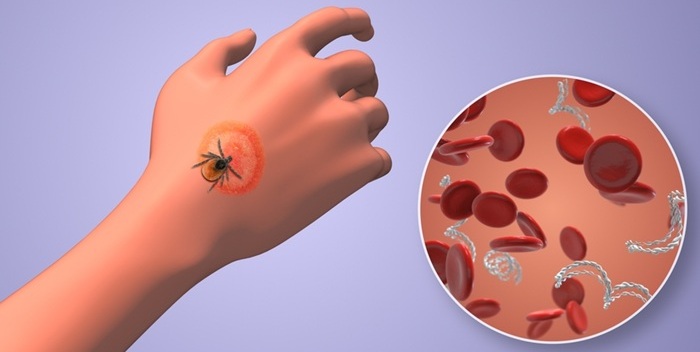Likely Flaws Uncovered for LM-Method for Lyme Disease Detection
|
By LabMedica International staff writers Posted on 12 Jul 2016 |

Image: An adult deer tick Ixodes scapularis. Lyme disease is caused by Borrelia bacteria and transmitted to humans upon the bite of infected ticks of the genus Ixodes (Photo courtesy of Scott Bauer, Agricultural Research Service of USDA / Wikimedia).
According to a new study, the recently developed modified microscopy technique “LM-method” of examining blood samples to help diagnose Lyme disease (and babesiosis) – is unable to distinguish infected patients from healthy controls, yielding many false-positive results.
While most people who contract Lyme disease recover quickly after antibiotic treatment, up to 20% of patients report persistent symptoms years after being told standard tests are negative for the disease. Interest in new diagnostic tests is therefore high.
The tick vector Ixodidae transmits Borrelia (bacterial causative agent of Lyme disease) as well as Babesia (parasitic protozoan causative agent of babesiosis). The new research follows up on a previous study suggesting that LM-method could detect active cases of disease caused by Borrelia and/or Babesia in just 1-2 days. Considerable publicity, and thereby patient demand, for this test in Norway continued despite that earlier studies did not include a control group and methods were not validated and ready for use in patients.
To investigate the reliability of the new test, Dr Audun Aase, from the Norwegian Institute of Public Health (Oslo, Norway), and colleagues collected blood samples from people who had been suffering from Lyme disease-like symptoms for several years and previously tested positive for Borrelia and/or Babesia infection using LM-method (21 people), and from healthy controls with no known history of tick bites (41 people). The samples were then masked and analyzed in independent laboratories using a range of diagnostic tests including the LM-method, conventional microscopy, genetic fingerprint testing (PCR), and serology.
The study indicated that LM-method results in high numbers of false positives: 14 (66%) patient-group samples and 35 (85%) control-group samples were judged positive for Borrelia and/or Babesia. However, only 1 sample (5%) of the patient-group and 8 samples (20%) of the control-group tested positive for Borrelia DNA by PCR. None of the samples were positive for Babesia DNA, and conventional microscopy did not identify Babesia in any of the samples. In conclusion, the structures interpreted as Borrelia and Babesia using LM-method could not be verified by PCR and the LM-method was thus falsified.
In an accompanying editorial commentary, Dr Ram B. Dessau, infectious diseases expert and senior consultant at Slagelse Hospital (Slagelse, Denmark), wrote: “I hope the study serves as a warning against non-validated microscopic procedures and helps prevent mismanagement of patients with chronic complaints, who are lured to seek improper diagnosis in the future.”
The study, by Aase A et al, was published online February 2016 in the journal Infectious Diseases.
Related Links:
Norwegian Institute of Public Health
While most people who contract Lyme disease recover quickly after antibiotic treatment, up to 20% of patients report persistent symptoms years after being told standard tests are negative for the disease. Interest in new diagnostic tests is therefore high.
The tick vector Ixodidae transmits Borrelia (bacterial causative agent of Lyme disease) as well as Babesia (parasitic protozoan causative agent of babesiosis). The new research follows up on a previous study suggesting that LM-method could detect active cases of disease caused by Borrelia and/or Babesia in just 1-2 days. Considerable publicity, and thereby patient demand, for this test in Norway continued despite that earlier studies did not include a control group and methods were not validated and ready for use in patients.
To investigate the reliability of the new test, Dr Audun Aase, from the Norwegian Institute of Public Health (Oslo, Norway), and colleagues collected blood samples from people who had been suffering from Lyme disease-like symptoms for several years and previously tested positive for Borrelia and/or Babesia infection using LM-method (21 people), and from healthy controls with no known history of tick bites (41 people). The samples were then masked and analyzed in independent laboratories using a range of diagnostic tests including the LM-method, conventional microscopy, genetic fingerprint testing (PCR), and serology.
The study indicated that LM-method results in high numbers of false positives: 14 (66%) patient-group samples and 35 (85%) control-group samples were judged positive for Borrelia and/or Babesia. However, only 1 sample (5%) of the patient-group and 8 samples (20%) of the control-group tested positive for Borrelia DNA by PCR. None of the samples were positive for Babesia DNA, and conventional microscopy did not identify Babesia in any of the samples. In conclusion, the structures interpreted as Borrelia and Babesia using LM-method could not be verified by PCR and the LM-method was thus falsified.
In an accompanying editorial commentary, Dr Ram B. Dessau, infectious diseases expert and senior consultant at Slagelse Hospital (Slagelse, Denmark), wrote: “I hope the study serves as a warning against non-validated microscopic procedures and helps prevent mismanagement of patients with chronic complaints, who are lured to seek improper diagnosis in the future.”
The study, by Aase A et al, was published online February 2016 in the journal Infectious Diseases.
Related Links:
Norwegian Institute of Public Health
Latest Microbiology News
- Rapid Assay Identifies Bloodstream Infection Pathogens Directly from Patient Samples
- Blood-Based Molecular Signatures to Enable Rapid EPTB Diagnosis
- 15-Minute Blood Test Diagnoses Life-Threatening Infections in Children
- High-Throughput Enteric Panels Detect Multiple GI Bacterial Infections from Single Stool Swab Sample
- Fast Noninvasive Bedside Test Uses Sugar Fingerprint to Detect Fungal Infections
- Rapid Sepsis Diagnostic Device to Enable Personalized Critical Care for ICU Patients
- Microfluidic Platform Assesses Neutrophil Function in Sepsis Patients
- New Diagnostic Method Confirms Sepsis Infections Earlier
- New Markers Could Predict Risk of Severe Chlamydia Infection
- Portable Spectroscopy Rapidly and Noninvasively Detects Bacterial Species in Vaginal Fluid
- CRISPR-Based Saliva Test Detects Tuberculosis Directly from Sputum
- Urine-Based Assay Diagnoses Common Lung Infection in Immunocompromised People
- Saliva Test Detects Implant-Related Microbial Risks
- New Platform Leverages AI and Quantum Computing to Predict Salmonella Antimicrobial Resistance
- Early Detection of Gut Microbiota Metabolite Linked to Atherosclerosis Could Revolutionize Diagnosis
- Viral Load Tests Can Help Predict Mpox Severity
Channels
Clinical Chemistry
view channel
Chemical Imaging Probe Could Track and Treat Prostate Cancer
Prostate cancer remains a leading cause of illness and death among men, with many patients eventually developing resistance to standard hormone-blocking therapies. These drugs often lose effectiveness... Read more
Mismatch Between Two Common Kidney Function Tests Indicates Serious Health Problems
Creatinine has long been the standard for measuring kidney filtration, while cystatin C — a protein produced by all human cells — has been recommended as a complementary marker because it is influenced... Read moreMolecular Diagnostics
view channel
Blood Test Accurately Detects Brain Amyloid Pathology in Symptomatic Patients
New research has reinforced the use of a novel blood test as a highly accurate tool for detecting brain amyloid pathology in symptomatic patients, helping healthcare professionals in diagnosing Alzheimer’s disease.... Read more
New Molecular Test Improves Diagnostic Accuracy of Lyme Disease
Diagnosing Lyme disease early remains one of the biggest challenges in infectious disease care. The condition is increasing across the United States, especially in the Northeast, although many patients... Read moreHematology
view channel
Platelet Activity Blood Test in Middle Age Could Identify Early Alzheimer’s Risk
Early detection of Alzheimer’s disease remains one of the biggest unmet needs in neurology, particularly because the biological changes underlying the disorder begin decades before memory symptoms appear.... Read more
Microvesicles Measurement Could Detect Vascular Injury in Sickle Cell Disease Patients
Assessing disease severity in sickle cell disease (SCD) remains challenging, especially when trying to predict hemolysis, vascular injury, and risk of complications such as vaso-occlusive crises.... Read more
ADLM’s New Coagulation Testing Guidance to Improve Care for Patients on Blood Thinners
Direct oral anticoagulants (DOACs) are one of the most common types of blood thinners. Patients take them to prevent a host of complications that could arise from blood clotting, including stroke, deep... Read moreImmunology
view channel
Chip Captures Cancer Cells from Blood to Help Select Right Breast Cancer Treatment
Ductal carcinoma in situ (DCIS) accounts for about a quarter of all breast cancer cases and generally carries a good prognosis. This non-invasive form of the disease may or may not become life-threatening.... Read more
Blood-Based Liquid Biopsy Model Analyzes Immunotherapy Effectiveness
Immunotherapy has revolutionized cancer care by harnessing the immune system to fight tumors, yet predicting who will benefit remains a major challenge. Many patients undergo costly and taxing treatment... Read morePathology
view channel
AI Tool Predicts Treatment Success in Rectal Cancer Patients
Artificial intelligence (AI) may soon help clinicians identify which rectal cancer patients are likely to respond well to treatment, using only the routine biopsy slides already obtained at diagnosis.... Read more
Blood Test and Sputum Analysis Predict Acute COPD Exacerbation
Chronic obstructive pulmonary disease (COPD) remains a major contributor to global illness, largely driven by cigarette smoking and marked by irreversible lung damage. Acute exacerbations can accelerate... Read more
AI Tool to Transform Skin Cancer Detection with Near-Perfect Accuracy
Melanoma continues to be one of the most difficult skin cancers to diagnose because it often resembles harmless moles or benign lesions. Traditional AI tools depend heavily on dermoscopic images alone,... Read more
Unique Immune Signatures Distinguish Rare Autoimmune Condition from Multiple Sclerosis
Myelin oligodendrocyte glycoprotein antibody–associated disease (MOGAD) is a rare autoimmune disorder in which the immune system attacks the myelin sheath in the central nervous system. Although symptoms... Read moreTechnology
view channel
AI Saliva Sensor Enables Early Detection of Head and Neck Cancer
Early detection of head and neck cancer remains difficult because the disease produces few or no symptoms in its earliest stages, and lesions often lie deep within the head or neck, where biopsy or endoscopy... Read more
AI-Powered Biosensor Technology to Enable Breath Test for Lung Cancer Detection
Detecting lung cancer early remains one of the biggest challenges in oncology, largely because current tools are invasive, expensive, or unable to identify the disease in its earliest phases.... Read moreIndustry
view channel
Abbott Acquires Cancer-Screening Company Exact Sciences
Abbott (Abbott Park, IL, USA) has entered into a definitive agreement to acquire Exact Sciences (Madison, WI, USA), enabling it to enter and lead in fast-growing cancer diagnostics segments.... Read more























